Letters from Lodi
An insightful and objective look at viticulture and winemaking from the Lodi
Appellation and the growers and vintners behind these crafts. Told from the
perspective of multi-award winning wine journalist, Randy Caparoso.
Lodi has become a new home for... natural wines!
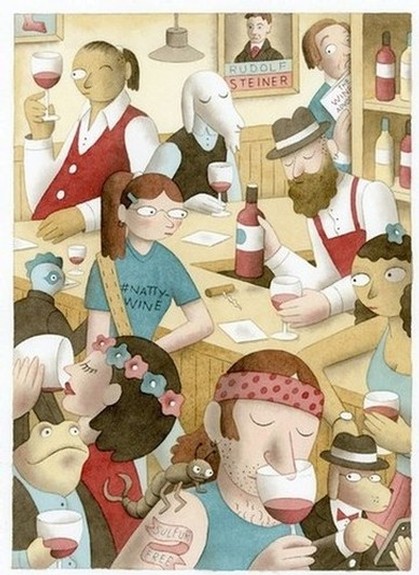
"Natural Wine," ©2022 Greg Clarke.
One of the most recent—many say surprising—movements within the international wine market has been towards the concept of "natural" wine. That is, wines grown and produced with minimal intervention; mostly by smaller, artisanal style wine producers, since it's the smaller, artisanal producers who are mostly interested in this style of wine.
This concept has hit home, here in California, and even here in Lodi. It may seem counter-intuitive that natural wines can be associated with Lodi. Lodi, after all, is where most of the big production wineries—producing wines that are more accurately described as products meant for the mass market—source their wine grapes.
The reasons are simple enough: Lodi has an ideal natural environment for growing quality wine grapes, especially at a cost that enables wineries to sell them between $5 to $20, the price range of over three-quarters of the bottles sold in the U.S.
But here's the other thing: This very same price range and grape-friendly terroir are also the reasons why many of today's small, artisanal, "cool kid" winemakers are now sourcing grapes from Lodi (please see our suggested sampling of artisanal, natural style wines listed at the end of this post). Five or ten years ago, many of Lodi's growers were reluctant to sell their grapes to these vintners. Why sell one or two tons to a bunch of itty-bitty wineries when you can sell 200 or 300 tons at a time to gigantic wineries?
Slowly but surely, however, these growers—most of them farming in Lodi for at least three generations (and many of them, families that have been here since the 1800s)—have been coming around to the idea of supplying the small fry as well.
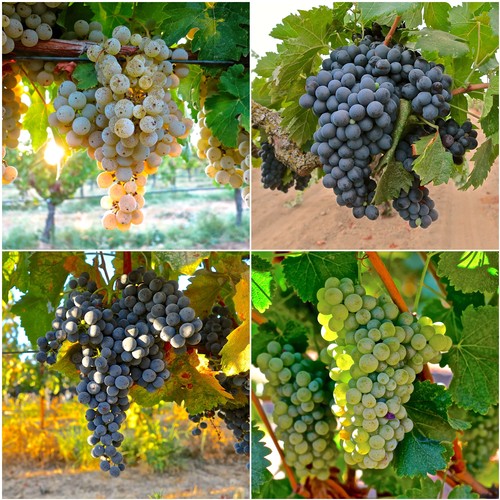
Four alternative grapes are grown in Lodi that is strongly favored by artisanal, natural style vintners (clockwise from top left): Kerner, Cinsaut, Chenin blanc, and Blaufränkisch.
The other big reason why more and more small production, natural style producers are sourcing from Lodi: The grape-friendly terroir and cost-effectiveness of winegrowing in Lodi also make Lodi the source of the largest variety of commercial wine grapes in America. Hence, the availability of a wide range of grape varieties—from Albariño to Zweigelt, Chenin blanc and Grenache blanc, Graciano and Nebbiolo, Piquepoul and Pinotage, Touriga and Tempranillo, et al. (see our past post, The 100 grapes of Lodi)— that are exactly the type of alternative cultivars many of today's alternative style producers are looking for.
What is natural wine and why is everyone talking (or complaining) about it?
The entire idea of "natural" wines as being a little more than offbeat, especially in America, is fairly new. Not more than five or six years old, as of this writing.
When consumers as well as the trade (i.e., the retail and restaurant industries) and media (especially online journalists, or the blogosphere) first began talking openly about this style of wine as a category in itself, there was a lot of pushback—let's be frank, more like a lot of moaning and growing—particularly among wine professionals speaking out for the more established, or conventional, wine production industry
The big complaint was that the term "natural" means nothing. This is true—there are no established guidelines or parameters by which wines purported to be natural are produced. At least, not until recently (last year France came out with official guidelines for the production of what is called Vin Méthode Nature—essentially, wines grown and produced by minimal intervention specifications).
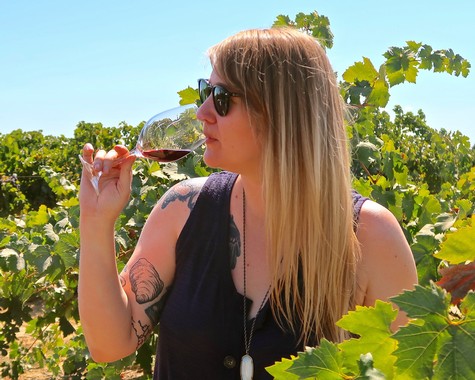
Austin, Texas sommelier Krista Church tasting a Lodi Native (i.e., fermented with natural yeast) Zinfandel in an ancient vine vineyard.
Then again, there have never been official guidelines for the use of many of the designations happily appearing on labels of wines grown all around the world. Terms such as "reserve," "old vine," "winemaker's selection," and so forth. Wine professionals and the worldwide wine production establishment have never complained about these types of verbiage, even when deceptively applied.
Why? Because those particular paradigms of vagueness—it is the height of cynicism, for instance, when wineries slap "proprietor's reserve" on labels of their cheapest, biggest production bottlings—seem to suit everyone's needs. The production industry, because it helps to sell wine; and dreamy aficionados and wine writers, because they love the mythical sides of wine appreciation, swallowing them hook, line, and sinker.
It is not as if proponents of natural-style wines are putting that right on the label. Most of them never mention it at all, even in their sales pitches. It is the consumers themselves, or the trade (e.g., "natural wine bars," sommeliers with natural wine predilections, etc.), who are embracing the concept.
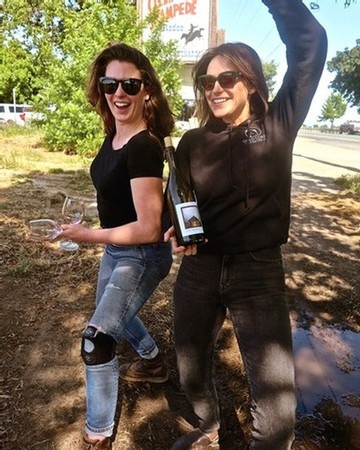
Little Trouble Wine Co. owner/winemakers Jennifer Reichardt and Sara Morgenstern revel in the high-acid grapes grown in Lodi's Stampede Vineyard to produce their low-intervention Zinfandel.
The other big complaint about natural wines has been that they just aren't any good. That they are often flawed, or downright "dirty." Two things fundamentally wrong with this contention:
1. There has never been any accounting for taste. Many wine lovers, for instance, absolutely adore light, fizzy, fruit-infused wines you can buy for $5.99. Who's to say these are not the greatest wines in the world for these consumers? Many wine lovers love a big, rich, oaky $250 California Cabernet Sauvignon, which many other wine lovers can't stand, and both opinions are perfectly valid. Just as consumers who love natural style wines—even if light, unpredictable, earthy, even occasionally funky—are also 100% "right." What's wrong is anyone who tells them they're wrong.
2. It is almost laughable to say that more predictable, clean-cut, commercial-style wines are, as a category in general, more acceptable or superior in quality. Any consumer would tell you that they wouldn't touch many commercial wines with a 10-foot pole. You may think natural-style wines in general are no good, but the average consumer could say the same thing about countless conventional wines.
There is an old phrase, once quoted by Shakespeare, that "good wine needs no bush"—which is to say, people will find and appreciate a good wine whether or not it is widely advertised. You can say the same thing about lousy wines, but the more important point is this: People can make up their own minds, and they do.
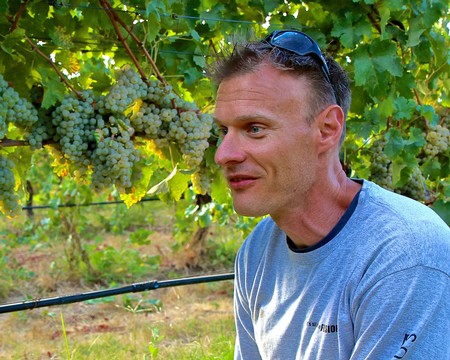
Lodi's Markus Niggli of Markus Wine Co., a Swiss-born winemaker who handles all his wines as naturally as possible, pictured with Kerner grapes are grown in Mokelumne Glen Vineyards.
In the November 2019 issue of The New Yorker, that rare and defiantly enduring bastion of the "long article" (i.e., one that devotes enough space to flesh out an idea), there was a story by Rachel Monroe entitled How Natural Wine Became a Symbol of Virtuous Consumption. Its subtitle: The mainstreaming of natural wines has brought niche winemakers capital and celebrity, as well as questions about their personalities and politics.
The New Yorker piece hit upon many of the reasons why natural wines are being taken seriously by a growing number of consumers. It began, wrote Monroe, as a "novelty," reflecting a "rejection of the high-tech methods that many conventional vintners relied on." As alternatives to that, natural style wines are "typically made with organic grapes, using no added yeast, no filtration, no chemical additives, no new oak barrels, no mechanical manipulations." While "variously described as low-intervention, naked, or raw... the term that eventually stuck was 'natural.'”
Conventionally conceived wines, Monroe points out, exist for a reason. They represent "greater consistency and precision... Wines being shipped across oceans could have longer shelf lives and more predictable tastes. The consolidation of the wine industry accelerated the trend since a mass-produced wine couldn’t afford to have an off year."
One of the movement's loudest proponents, adds Monroe, has been a New York City writer named Alice Feiring. Monroe quotes Feiring as telling her that the "wine world" found itself "in deep shit," especially when quality became more and more associated with high scores awarded on 100-point scales. "High-scoring bottles often sold out immediately... which meant that there was a strong financial incentive to make the kind of jammy and oaky high-alcohol wines" appealing to certain 100-point critics.
"This homogenizing effect appalled Feiring," wrote Monroe. Wine quality largely became defined by wines having "no sense of place." Feiring, adds Monroe, "also described wines she disliked as 'stupid,' 'emasculated,' 'some Body Shop concoction,' 'the vinous equivalent of bottle blonds,' 'airbrushed,' and 'dead.'"
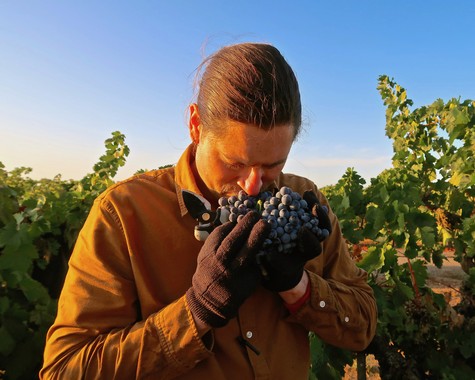
Chicago sommelier Nick Gaspar breathing in sustainably grown, ancient vine Lodi Carignan.
The natural wine movement pushes back
The growing number of small, independent, artisanal style producers in the U.S. did not need an evangelical such as Feiring to point out the way. I'd wager many of them have never read an article written by Feiring, and have probably never read the 2019 The New Yorker article on natural wines. Most of them began pushing back against the obvious commercial homogenization of wines of their own volition. It is natural, that is to say, to think "natural"—to conclude that the best wines are made to be unique unto themselves rather than like Xeroxed copies of countless other wines. And of course, many domestic devotees of natural winemaking have been inspired by European wines, which have been made in this style, like, forever.
Winemaking, after all, has always involved an artistic instinct, even though it also involves a large degree of rigor associated with science or many of the crafts. If anything, winemaking as well as winegrowing have always been associated with artistry, craftsmanship, and many of the things requiring individuality of thought, or ingenuity. This is being human.
Especially wines meant to express the age-old French concept of terroir, or "sense of place"—wines meant to taste like the vineyards or regions where they are grown, rather than as duplicates of preconceived notions of sensory qualities meant to meet, say, the expectations of the commercial market, or to garner high scores in popular magazines to be more sellable.
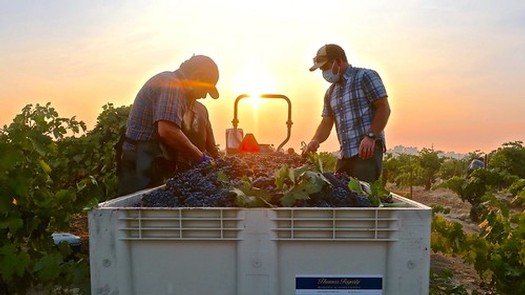
Precedent owner/winemaker Nathan Kandler (right), a decidedly minimal intervention vintner who produces spectacular wines from Lodi old vine growths such as Kirschenmann Vineyard, is shown here.
Take, for instance, Lodi's homegrown movement, started in 2012, called the "Lodi Native" project (re our post, Alternative style wines reflect the wave of the future). The Lodi Native Zinfandels were originated by a small group of Lodi vintners endeavoring to produce bottlings of this variety from older plantings (at least 100 years old), and to taste as much as possible like these individual vineyards.
The overarching goal, plain and simple, was to shine a spotlight on these vineyards, thereby highlighting the unique sensory attributes of Lodi-grown wines and what makes them different from wines grown in any other region of the world.
The Lodi Native group did not use the term "natural," but in order produce Zinfandels that taste like vineyards rather than an intended style of a commercial brand or even a preconceived notion of "Zinfandel" as a varietal, these vintners had to make these wines as naturally as possible. Beginning with fermenting these Zinfandels with the native yeast naturally found on the skins of the grapes, rather than by inoculating fermentations with commercial yeasts designed to achieve sensory profiles not necessarily associated with those vineyards. Then they needed to go further by eschewing enzymes, oak amendments, filtration, new oak barrels, or anything else that can possibly alter the sensory profiles indigenous to each individual vineyard.
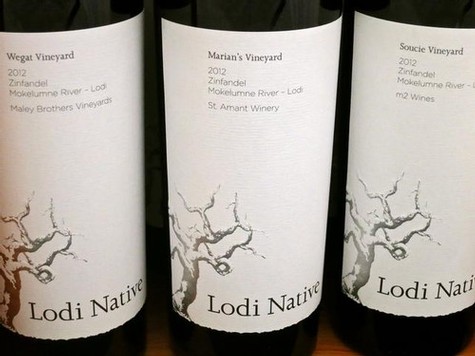
Lodi Native Zinfandel bottlings: natural style wines showcasing different vineyards.
In his award winning Vinography wine blog, the widely followed wine journalist Alder Yarrow confessed that he had long "fell out of love with Zinfandel." But upon first tasting the Lodi Native Zinfandels, he found that...
The wines are a revelation. Are they the best Zinfandels made in California? Not by a long shot. But that's not the point. Instead, they may well be the among the most honest Zinfandels made in California.
Sure, there are other wine producers out there that have been making elegant, native fermented Zinfandels with little oak influence for years, but they are isolated producers. Drinking their wines in isolation provides great pleasure, but not a lot of perspective on either their regions or the Zinfandel grape, if only because none of their neighbors are making wine in the same way.
The Lodi Native project, on the other hand, provides a unique and crystal-clear window into the synergy of a place and a grape that is captured in the notion we call terroir. Along the way, this experiment is changing the hearts and minds of winemakers, as well as wine writers like myself. I'm ready to start buying Zinfandel again, especially if it tastes like that.
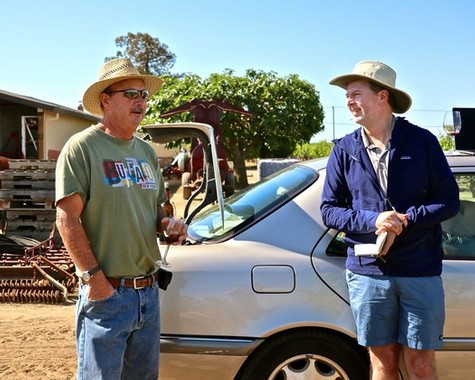
Vinography author Alder Yarrow (right) with third generation Lodi winegrower Kevin Soucie.
The Lodi Native protocols are pretty much an echo of the practices of many vintners now associated with the natural movement. Many vintners who are considered "natural," in fact, are like the Lodi Native producers because they do not adopt methodologies in order to be "natural." They do what they do in order to make wines that taste as much as possible like where they come from, the grapes they are made from, or the vagaries of each vintage. They are allergic to sameness, and aspire to authenticity. Being natural is a means, not a goal in itself.
Many of these wines, in fact, happen to be lighter and have a fresher sense of acidity and fruit profile; mostly because it's easier to produce minimal intervention, native yeast fermented wines when grapes are picked earlier in the season when they have lower sugar and higher acidity, which result in fresher, lower alcohol, higher acid wines. Precisely the sensory qualities many of today's aficionados of natural style wines are looking for.
Many of these wines, by nature of these methodologies, are also unpredictable. The bottlings of each and every vintage is different because Nature does not allow the grapes in any given vineyard to grow exactly the same way each year. It's a physical impossibility. Every vintage is an adventure. Heck, every bottle from every vintage can be an adventure. But that's precisely the point, if you're a natural wine lover.
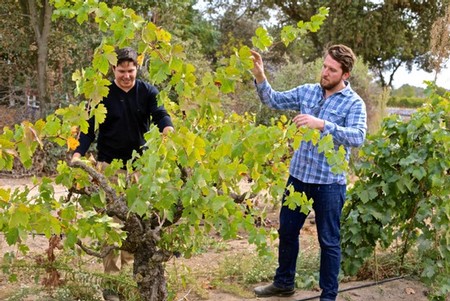
Maître de Chai owner/winemakers Alex Pitts and Marty Winters in Clements Hills-Lodi's Stampede Vineyard, examining the old vines they crave for their minimal intervention style Zinfandel.
A natural wine sampler
The following list is by no means a comprehensive accounting of natural style wines grown in Lodi. It is, however, a list of some of the finest wines in terms of pure quality. Wines that would warm the cockles of the heart of almost any aficionado of these alternative wines. Wines that also happen to reflect the diversity of grapes grown in this region. Prices may vary, depending upon the source, and so we are proffering approximations.
Happy hunting!
2019 BIRICHINO, Bechthold Vineyard, Lodi Cinsaut ($24)
2019 BIRICHINO, Mule Plane Vineyard, Lodi Carignan ($24)
2018 Bold, Lodi Grenache ($30)
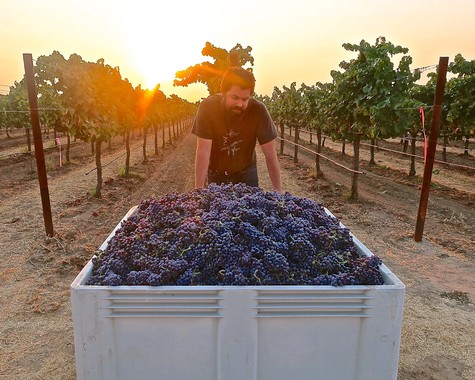
Enfield owner/winemaker John Lockewood with Abba Vineyard Grenache, grown in Lodi's Mokelumne River AVA.
2020 Enfield, Abba Vineyard Lodi Grenache ($36)
2019 Fields Family, Bechthold Vineyard, Mokelumne River-Lodi Cinsaut ($28)
2021 Fields Family, Estate, Mokelumne River-Lodi Grenache Blanc ($24)
2018 Fields Family, Estate, Mokelumne River-Lodi Syrah ($28)
2018 Fields Family, Stampede Vineyard, Clements Hills-Lodi Zinfandel ($28)
2020 Ferdinand, Borden Ranch-Lodi Albariño ($20)
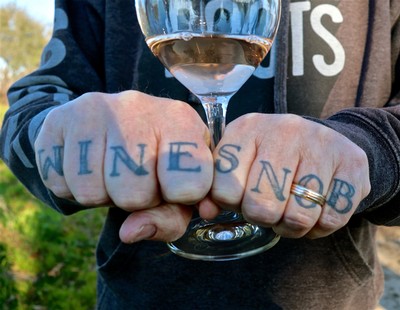
Artisanal style winemaker Craig Haarmeyer sends a subtle message through his hands.
2020 Haarmeyery, Palmero Family Vineyard, Borden Ranch-Lodi Chenin Blanc ($24)
2019 Haarmeyer Wine Cellars, Stampede Vineyard, Clements Hills-Lodi Zinfandel ($39)
2019 Hatton Daniel, Mokelumne Glen Vineyard, Lodi Blaufränkisch ($24)
2019 Hatton Daniels, Mokelumne Glen Vineyard, Lodi Rosé of Dornfelder ($24)
2018 Hatton Daniels, Mokelumne Glen Vineyard, Lodi Zweigelt ($24)
2021 Iconic, "Myriad" Clements Hills-Lodi Cinsaut ($25)
2021 Iconic, "Old Gods" Mokelumne River-Lodi Zinfandel ($28)
2021 Little Trouble, Heritage Field Blend Red, Clements Hills-Lodi (Zinfandel/Mission/Mourvèdre/Alicante Bouschet/Flame Tokay; $36)
2020 Lodi Native (by St. Amant), Marian's Vineyard (Zinfandel; $35)
2018 Lodi Native (by Maley Bros.) Wegat Vineyard (Zinfandel; $35)
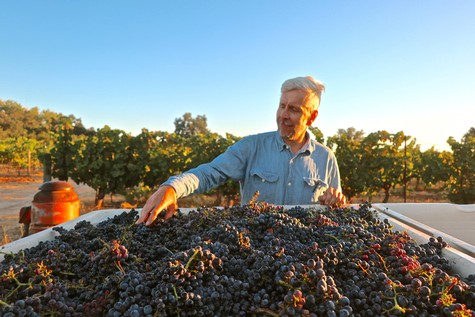
Trail Marker co-owner/winemaker Drew Huffine with 2022 Lodi-grown Blaufränkish which he picks early (at 22º Brix) with higher acidity in order to produce the wine with as little intervention (i.e., in "natural" fashion) as possible.
2021 Maître de Chai, Buckaroos Stampede Vineyard, Clements Hills-Lodi Zinfandel Rosé ($25)
2020 Maître de Chai, Stampede Vineyard, Clements Hills-Lodi Zinfandel ($30)
2020 Marchelle, 1900 Block, Mokelumne River-Lodi Carignan ($48)
2020 Marchelle, Bechthold Vineyard, Mokelumne River-Lodi Cinsaut ($54)
2020 Marchelle, Lodi Old Vine Red (Carignan/Cinsaut/Zinfandel; $48)
2020 Marchelle, Royal Tee Block, Mokelumne River-Lodi Zinfandel ($48)
2019 Markus Wine Co., Bechthold Vineyard, Lodi Ancient Blocks Bechthold (Cinsaut/Syrah; $39)
2018 Markus Wine Co., Lodi Domo (Carignan/Merlot/Zinfandel; $39)
2021 Markus Wine Co., Mokelumne Glen Vineyards, Lodi Nativo (Kerner/Bacchus/Riesling; $22)
2019 Markus Wine Co., Lodi Zeitlos (Syrah/Cinsaut/Petite Sirah; $39)
2021 McCay, Bechthold Vineayrd, Mokelumne River-Lodi Cinsaut Rosé ($35)
2019 McCay, Bechthold Vineyard, Mokelumne River-Lodi Cinsaut ($35)
2019 McCay, Abba Vineyard, Mokelumne River-Lodi Grenache ($35)
2017 McCay, Rous Vineyard Reserve, Mokelumne River-Lodi Zinfandel ($42)
2017 McCay, TruLux Vineyard, Mokelumne River-Lodi Zinfandel ($35)
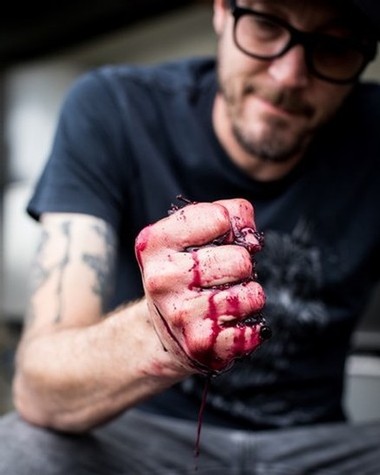
Monte Rio owner/winemaker Patrick Cappiello, who seeks to capture a "raw," unfettered power in his Lodi-grown wines.
2021 Monte Rio, Lodi Mission ($21)
2021 Monte Rio, Lodi Petite Sirah ($23)
2021 Monte Rio, River's Edge Vineyard, Lodi Sangiovese ($23)
2021 Monte Rio, Lodi Zinfandel ($23)
2019 Neyers Vineyards, Sage Canyon California Red Wine (Carignan/Mourvèdre/Grenache; $30)
2019 Neyers Vineyards, Vista Notre, California Zinfandel ($30)
2020 Perlegos Family, Sprague Vineyard, Clements Hills-Lodi Cinsaut ($28)
2019 Precedent, Spenker Ranch, Mokelumne River-Lodi Carignan ($28)
2019 Precedent, Kirschenmann Vineyard, Mokeumne River-Lodi Zinfandel ($28)
2021 Trail Marker, Mokelumne Glen Vineyard, Lodi Blaufränkisch ($30)
2021 Trail Marker, Mokelumne Glen Vineyard, Lodi Kerner ($30)
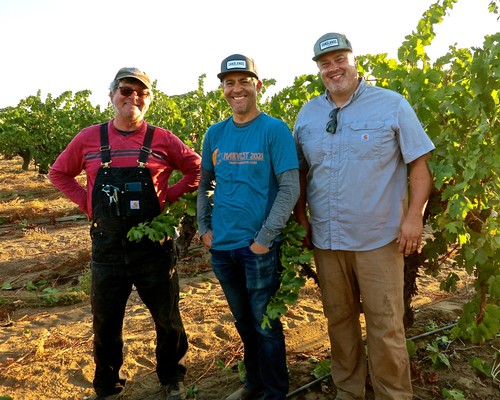
Three highly acclaimed, natural style winemakers—(from left) Greg La Follette (Marchelle Wines), Tadeo Borchardt (Neyers Vineyards), and Tegan Passalacqua (Sandlands and Turley Wine Cellars)—all coming together to pick Carignan from Lodi's Spenker Ranch, planted in 1900, for their respective labels.
2018 Sabelli-Frisch, El Aliso, Somers Vineyard, Angelica (Mission; $49)
2019 Sabelli-Frisch, La Malinche, Somers Vineyard, Mission ($29)
2021 Sabelli-Frisch, Mariedam, Stampede Vineyard, Clements Hills-Lodi White Zinfandel ($27)
2020 Sabelli-Frisch, Milk Fed 4, Mokelumne Glen Vineyard, Mokelumne River-Lodi Zweigelt ($32)
2021 Sandlands, Lodi Cinsaut ($40)
2019 Sandlands, Lodi Red Table Wine (Zinfandel/Carignan/Cinsaut; $35)
2019 Sandlands, Lodi Zinfandel ($40)
2021 Turley, Bechthold Vineyard, Mokelumne River-Lodi Cinsaut ($25)
2020 Turley, Dogtown Vineyard, Clements Hills-Lodi Zinfandel ($50)
2020 Turley, Kirschenmann Vineyard, Mokelumne River-Lodi Zinfandel ($50)
2020 Turley, Steacy Ranch, Mokelumne River-Lodi Zinfandel ($45)
2021 Turley, Lodi Zinfandel Rosé ($25)
2020 Two Shepherds, Bechthold Vineyard, Lodi Cinsaut ($38)
2020 Voluptuary (by Lucid), v. 03, The Lover, Skin-Contact Picpoul Blanc ($38)
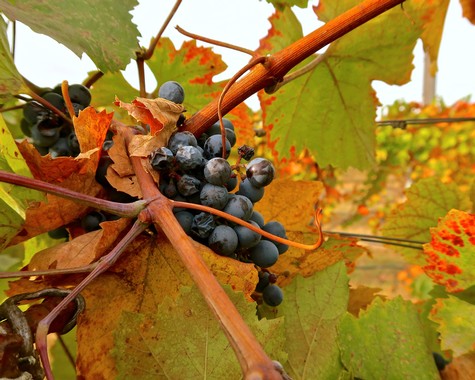
Unpicked 2022 Zweigelt in Lodi's Mokelumne Glen Vineyards.